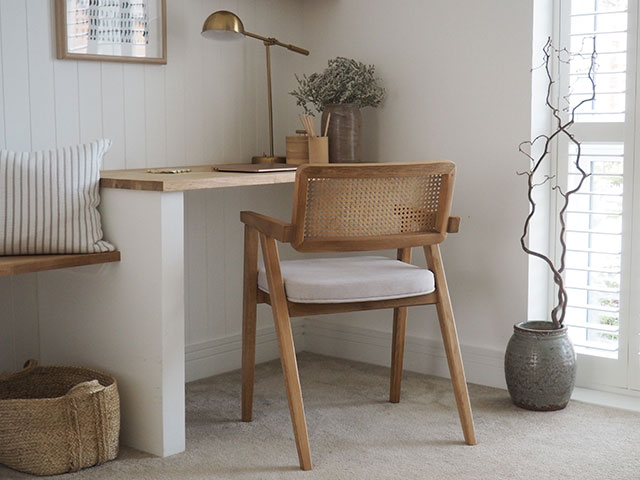
biophilic design in the bedroom
Everything you need to know about biophilic design
Biophilic interior design is a huge trend that has been steadily growing since 2020. What started in the world of design and wellness architecture has now become a firm favourite among interior design trends. It’s all about connecting with nature in our homes. But why does that matter? And how do you get the look at home? Good Homes talks to those in the know…
What is biophilic design?
According to biologist E.O Wilson, biophilia is the ‘innate and genetically determined affinity of human beings with the natural world’. Bringing that into our homes can help improve our wellbeing, regulate our nervous systems, and evoke a sense of peace and calm.
Urbanisation has dramatically impacted the amount of greenery we see during our daily lives, and repeated lockdowns during the pandemic meant we all had to spend more time indoors. Couple that with an increased awareness of wellbeing and biophilic interior design becomes less of a trend and more of a way of life.
To find out more about it, Good Homes chats to Biophilic Interior Designer Lucy Gleeson…

Photo: Lucy Gleeson
How did you get in biophilic design?
I got in to biophilic design as I have always had a strong interest in the health benefits of the outdoors, so it felt the perfect combination, pairing it with interiors.
What are your favourite ways of incorporating biophilia in your designs?
My favourite ways of incorporating biophilia in my designs really depends on the client’s taste but the use of colour, light, suitable house plants and texture plays a big part every time.
What does biophilic interior design mean to you in your own home?
In my own home I make sure this applies and that the balance is right. It’s amazing what a soothing hue can do. My personal favourites are teal, blush pink, greens, and golds.
How do you find biophilia helps your clients?
Biophilia helps my clients by connecting them more to nature and this immediately reduces stress and encourages a sense of calm in their home. If you imagine how you feel in your favourite outdoor space – that’s the aim for me when it comes to design.
How to bring biophilic interior design into your home
1. Use colours of nature
The colour green is an integral element of biophilic design and with its calming properties it’s proven to lower your heart rate and stress levels. The hues of green in nature run the gamut from the iridescent wings of the jewel beetle to the deep emeralds of a rainforest to the chartreuse of an orange blossom tree. Interestingly, the human eye sees more shades of green than any other colour. In her book Biophilia: You + Nature + Home Sally Coulthard delves into the ways using different colours in nature make us feel and replicating it in our homes, and it’s not just the greens. Think grounding earthy tones and frothy turquoise sea foams.

Photo: Waters Baths of Ashbourne
2. Maximise natural light
Artificial lighting can mess with our circadian rhythms and disrupt our sleep-wake cycles, and with an increase in time spent indoors, letting natural light in (and getting more vitamin D) has never been more important. To maximise light, space and fresh air, bi-fold doors with a concertina design are able to open up a whole wall, while skylights, Velux roof windows and adding glass partitions to separate rooms, can all flood extra light in.
Biophilic Interior Designer Oliver Heath recommends thinking about how you use your spaces moving your furniture near to the windows to maximise your exposure to natural light through the day. If you work from home, could you have your desk looking out of a window, or to the garden? Mirrors are also a great way of reflecting natural light.

Photo: Furniture and Choice
3. Use natural materials
Organic shapes and natural materials will bring a textural richness to your biophilic interior design. From flooring to furniture, the tactility of a smooth warm wood or polished stone is instantly calming and feels great when mixed with rougher natural materials like a woven upholstery or a coir rug. Bamboo, rattan, cork, and jute are other great sustainable materials to incorporate into your interiors and mid-century furniture often has beautiful, curved lines.

Photo: Divine Savages
4. Bring in the plants
When it comes to biophilic interior design you can never have enough plants. Firstly, there’s the health benefits; with a natural filtering system by removing the carbon dioxide they’ll improve your air quality and by adding oxygen will help you sleep better at night. To keep it as natural as possible vary the colour, heights, shapes, and sizes of your plants. Large plants, like a monstera or a yucca can add character and make a statement. Make the most of vertical space with hanging plants or dot them about your shelves.

Photo: Porcelain Superstore
5. Engage your senses
Biophilic design works because the senses are satisfied. With sustainable materials, organic shapes and colours of the natural environment gratifying sight and touch, it’s important to bring in smell and sound. A crackling fire is instantly calming but if that’s not possible, add some large multi-wicked candles for a chilled ambiance. The benefits of smell on the way we feel are massive, reed diffusers are good for a subtle change, but to properly permeate the space, Neom or White Company’s pods work a treat, filled with essential oils like sweet basil, jasmine, lavender, sandalwood and neroli.

Cult Furniture






